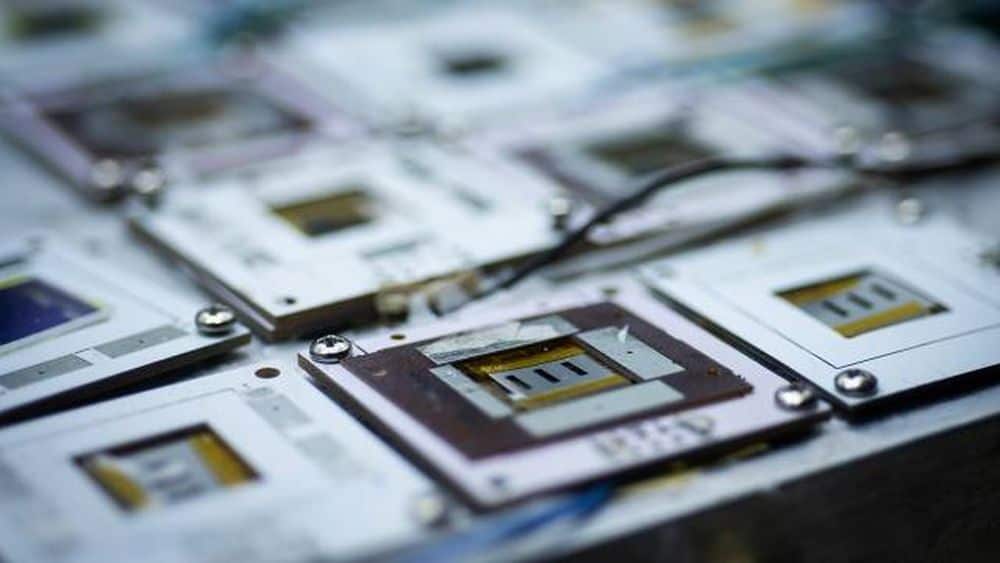
[Image above] An array of perovskite solar cells sits under bright light at high temperatures during an accelerated aging test developed by Princeton and Linköping researchers. Credit: Bumper DeJesus, Andlinger Center for Energy and the Environment
By Laurel Sheppard
Since Bell Labs announced the invention of the first practical silicon solar cell in 1954, silicon solar cells have dominated the photovoltaic market. However, these cells are close to reaching their theoretical efficiency limit, so scientists hope a special group of materials called perovskites could push efficiency to new heights.
Perovskites are compounds with the same type of crystal structure as calcium titanium oxide, the mineral traditionally referred to as perovskite. When arranged in tandem with silicon, perovskites can greatly increase the power conversion efficiency of solar cells. In addition, perovskite solar cells can
- Be made at room temperature, thus lowering fabrication costs;
- Be used to design flexible and transparent solar cells, thus expanding applications; and
- Have tailorable properties for specific applications and for combining with different platforms.
The lifetime of perovskite solar cells is the main factor hindering their commercialization. Perovskite solar cells tend to deteriorate in sunlight much faster than their silicon counterparts, lasting on average just a few hundred or thousand hours rather than years.
However, compared to the early perovskites a decade ago that lasted only minutes, the lifetime is improving thanks to new compounds and structural designs. But as lifetime improves, researchers run into another hurdle—verifying the stability of these materials on the timescale of months and years.
Fortunately, accelerated aging tests can overcome the need for real-time testing. Accelerated aging tests for organic- and silicon-based photovoltaics involve quantifying the lifetime acceleration factor, which relates the lifetime under a defined standard operating condition to the lifetime under elevated stress conditions. Developing such factors for perovskites is challenging, though, because they are quite sensitive to temperature, light, and electrical stimuli.
Princeton University and Linköping University (Sweden) researchers recently proposed a new method for performing accelerated aging tests on perovskites. Their method combines constant illumination (simulating full-spectrum sunlight) with elevated temperatures (up to 110°C) at the maximum power point of the solar cells. Measurements are conducted at four different aging temperatures (35°C, 59°C, 85°C, 110°C), and this data is used to forecast the device’s performance at room temperature over tens of thousands of hours of continuous illumination.
They used the new accelerated aging test to evaluate a CsPbI3 perovskite solar cell featuring an ultrathin capping layer to optimize light absorption while improving durability. The ultrathin capping layer (only a few atoms thick) of Cs2PbI2Cl2 was synthesized between the perovskite active layer and the hole transport layer by treating the CsPbI3 surface with a cesium chloride solution, followed by thermal annealing.
The researchers successfully described degradation rates for the CsPbI3 perovskite cells using a single Arrhenius function across the entire temperature range. This result suggests the same mechanism is responsible for degradation regardless of temperature, which is an important criterion for conducting a reliable accelerated aging test.
Further proof that degradation was caused by the same mechanism came from multiplying the aging time by the acceleration factor, which resulted in an equivalent operating time (at a reference temperature of 35°C) for devices aged at elevated temperatures. All the data could be plotted on one curve for both capped and uncapped solar cells.
Testing showed that the CsPbI3 perovskite solar cells with an ultrathin capping layer demonstrated improved power conversion efficiency (17.4%) compared to cells without a capping layer (14.9%). The researchers state that this efficiency is the highest among fully inorganic perovskite solar cells in which all the functional materials in the stack are inorganic.
CsPbI3 cells with the capping layer did not degrade at 35°C and required more than 2,100 hours at 110°C under constant illumination to degrade by 20% of their initial efficiency. Degradation acceleration factors predicted an intrinsic lifetime of more than 5 years, which equals 30 years of outdoor operation in a climate like Princeton, New Jersey. The current threshold for state-of-the art silicon solar cell lifetime is rated at 20 years.
In a Princeton press release, Yueh-Lin (Lynn) Loo, senior author and Theodora D. ’78 and William H. Walton III ’74 Professor in Engineering at Princeton, says while the record-setting solar cell highlights the durable potential of perovskite solar cells, the new accelerated aging test is the study’s deeper significance.
“We might have the record today, but someone else is going to come along with a better record tomorrow. The really exciting thing is that we now have a way to test these devices and know how they will perform in the long term,” she says.
The paper, published in Science, is “Accelerated aging of all-inorganic, interface-stabilized perovskite solar cells” (DOI: 10.1126/science.abn5679).
